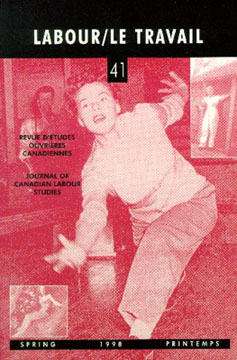Abstract
Until the Communist Party of Canada (CPC) turned to the tactic of Class Against Class in 1928-29, it confined its trade-union work almost wholly to "boring from within" the international craft unions of the American Federation of Labor/Trades and Labour Congress of Canada. Although "the party" played a dominant part in the very limited industrial conflict of the 1920s, its attempt to transform the international unions into organs of class struggle was wholly unsuccessful, in part because its "line" presumed a far higher degree of rank and file combativeness than actually existed, and in part because Canadian "labourists" actively resisted its best efforts. Where the CPC believed that the international unions needed to be "renovated," the internationals themselves disagreed. Socialist Plumbers' official John W. Bruce posed the question "Does the International Labour Movement need Salvaging?" which he then answered — to general labourist approval — by reaffirming the progressive character of craft unionism and its tried and tested, non-revolutionary methods. The party's failure to break through this complacency — and labourists' growing resentment of its attempts to do so — predisposed it to accept the Comintern's "New Line" in 1928.
Résumé
Jusqu'à ce que le Parti Communiste du Canada (PCC) adopte la tactique de «classe contre classe» en 1928-1929, son activité syndicale s'est limitée presqu'exclusivement à une tactique d'infiltration («boring from within») des syndicats internationaux affiliés à la Fédération Américaine du Travail (FAT) et au Congrès Canadien du Travail (CCT). Bien que le Parti ait joué un rôle dominant dans divers conflits industriels au cours des années 1920, sa tentative pour transformer les syndicats internationaux en organes de luttes de classe a subi un échec, en partie parce qu'il présumait un degré de combativité à la base de loin supérieur à ce qui existait en fait, et en partie en raison de la résistance des «travaillistes» Canadiens. Le PCC croyait que les syndicats devaient se «rénover»; une idée que les syndicats internationaux eux-mêmes ont rejetée. Cette opinion a été exprimée par le socialiste John W. Bruce, représentant de l'union des plombiers, lorsqu'il a posé la question:« Est-ce que le mouvement ouvrier international a besoin d'être sauvé?» La solution se trouvait, à son avis et de l'avis du mouvement travailliste en général, dans la réaffirmation du caractère progressiste du mouvement syndical et de ses méthodes non-révolutionnaires. L'incapacité du Parti à aller au-delà de cette complaisance — et le ressentiment croissant des travaillistes face aux efforts du Parti — l'aprédisposé à accepter la «Nouvelle Ligne» du Comintern en 1928.
